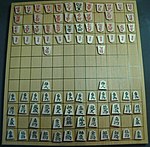
Space shogi is a three-dimensional shogi variant invented by George R. Dekle Sr. in 1987. The gamespace comprises nine 9×9 shogi boards stacked vertically. Each player controls a standard set of shogi pieces.
Space shogi was included in World Game Review No. 10 edited by Michael Keller.
Game rules
Space shogi follows standard shogi conventions, including the same types and numbers of pieces, and a similar initial setup. All the normal shogi rules apply, including drops, promotion, check, checkmate, and impasse. But pieces have the freedom of three-dimensional movement.
Starting setup
Black starts the game occupying levels 1 through 3; White starts on levels 9 through 7.
 Black's level 1 (and White's level 9, rank a) starting setup. Unlike standard shogi, the silver is placed between the lance and the knight (8i and 2i in the diagram).
Black's level 1 (and White's level 9, rank a) starting setup. Unlike standard shogi, the silver is placed between the lance and the knight (8i and 2i in the diagram). Black's level 2 (and White's level 8, rank b) starting setup. The bishop and rook occupy the same positions as in standard shogi.
Black's level 2 (and White's level 8, rank b) starting setup. The bishop and rook occupy the same positions as in standard shogi. Black's level 3 (and White's level 7, rank c) starting setup. The pawns fill the same rank as in standard shogi.
Black's level 3 (and White's level 7, rank c) starting setup. The pawns fill the same rank as in standard shogi.
See also
- Three-dimensional chess
- Also by George Dekle:
- Hexshogi – a variant with hexagonal cells
- Trishogi – a variant with triangular cells
- Masonic shogi – a variant with standard cells but staggered ranks
References
- Pritchard (1994), p. 285
- Pritchard (2007), p. 261
- Keller, Michael, ed. (June 1991). "A Panorama of Chess Variants". World Game Review. No. 10. Michael Keller. ISSN 1041-0546.
Bibliography
- Pritchard, D. B. (1994). The Encyclopedia of Chess Variants. Games & Puzzles Publications. ISBN 0-9524142-0-1.
- Pritchard, D. B. (2007). Beasley, John (ed.). The Classified Encyclopedia of Chess Variants. John Beasley. ISBN 978-0-9555168-0-1.
| Shogi variants | ||
|---|---|---|
| Standard shōgi (9×9, drops) | ||
| Small variants |
|  |
| Standard-size variants |
| |
| Large variants |
| |
| Multiplayer variants |
| |
| 3D variants |
| |
| Miscellaneous variants |
| |